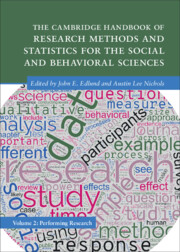 The Cambridge Handbook of Research Methods and Statistics for the Social and Behavioral Sciences
The Cambridge Handbook of Research Methods and Statistics for the Social and Behavioral Sciences Book contents
- The Cambridge Handbook of Research Methods and Statistics for the Social and Behavioral Sciences
- Cambridge Handbooks in Psychology
- The Cambridge Handbook of Research Methods and Statistics for the Social and Behavioral Sciences
- Copyright page
- Dedication
- Contents
- Figures
- Tables
- Contributors
- Preface
- Part I Quantitative Data Collection Sources
- Part II Important Methodological Considerations
- 9 Reliability
- 10 Measurement Validity in the Social and Behavioral Sciences: Some “Whys” and “Hows”
- 11 Statistical Power: How Not to Miss What’s Right in Front of You
- 12 Interdisciplinary and Integrative Research
- 13 The Importance of Replication
- 14 The Inner Workings of Registered Reports
- Part III Self-Report Measures
- Part IV Behavioral Measures
- Part V Physiological Measures
- Part VI Qualitative Data Collection Sources
- Index
- References
11 - Statistical Power: How Not to Miss What’s Right in Front of You
from Part II - Important Methodological Considerations
Published online by Cambridge University Press: 12 December 2024
- The Cambridge Handbook of Research Methods and Statistics for the Social and Behavioral Sciences
- Cambridge Handbooks in Psychology
- The Cambridge Handbook of Research Methods and Statistics for the Social and Behavioral Sciences
- Copyright page
- Dedication
- Contents
- Figures
- Tables
- Contributors
- Preface
- Part I Quantitative Data Collection Sources
- Part II Important Methodological Considerations
- 9 Reliability
- 10 Measurement Validity in the Social and Behavioral Sciences: Some “Whys” and “Hows”
- 11 Statistical Power: How Not to Miss What’s Right in Front of You
- 12 Interdisciplinary and Integrative Research
- 13 The Importance of Replication
- 14 The Inner Workings of Registered Reports
- Part III Self-Report Measures
- Part IV Behavioral Measures
- Part V Physiological Measures
- Part VI Qualitative Data Collection Sources
- Index
- References
Summary
In this chapter, we discuss the definitions of power and how to interpret power in Null Hypothesis Significance Testing. Next, the main determinants of power are outlined, including the sample size, effect size (and variability), α, and the type of statistical test. Each influence on power is demonstrated with example studies on statistics education and data literacy. Different types of power analyses, planning for sample sizes and sensitivity, are illustrated using power tables, popular programs, simulation, and accuracy in parameter estimation. Last, the limitations of power – especially what it does not tell you and what you should not do – are outlined to warn you about the potential misuses of power analyses. Suggestions on appropriate power planning are provided at the end of the chapter.
- Type
- Chapter
- Information
- The Cambridge Handbook of Research Methods and Statistics for the Social and Behavioral SciencesVolume 2: Performing Research, pp. 232 - 260Publisher: Cambridge University PressPrint publication year: 2024
